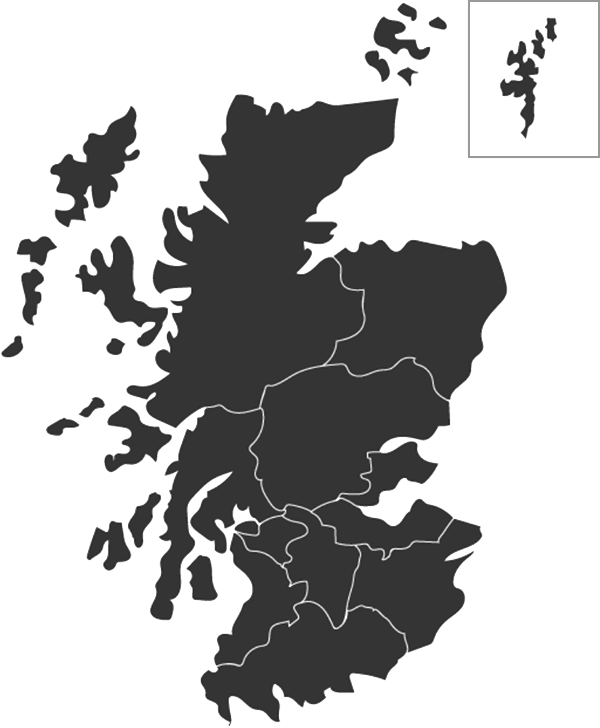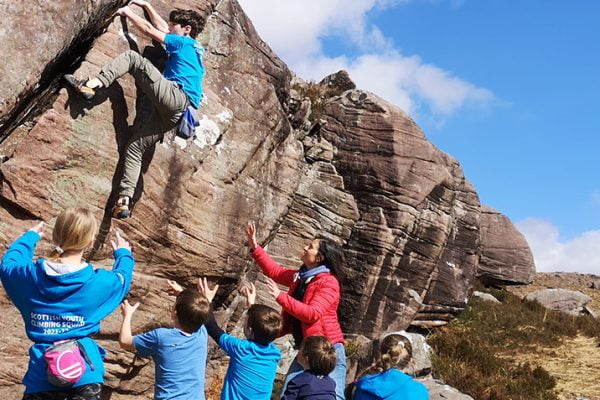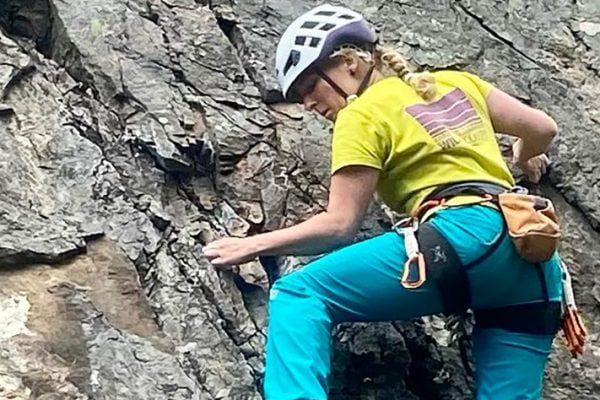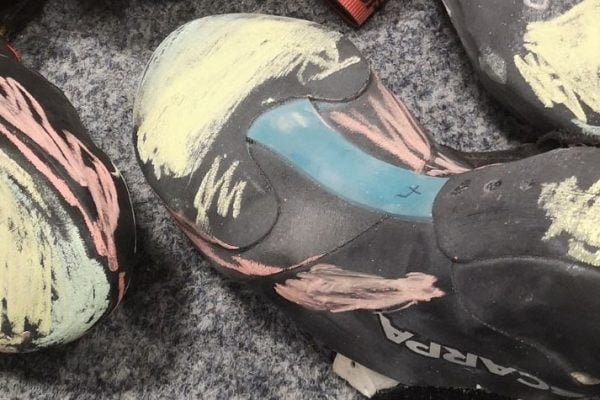Climbing is a perfect activity for Scotland’s unpredictable weather as you can do it both indoors and outdoors.
Click on the links below to find out more about each type of climbing and the techniques, equipment and challenges involved:
Bouldering
Bouldering is one of the simplest forms of climbing to get involved with. You may even have done it already without knowing.
It requires minimal equipment to get started, if any at all. Climbing shoes, a boulder pad and chalk will get you off to a good start. There are natural boulders all over Scotland, literally so many you are unlikely ever to have enough time to visit them all. Most climbing walls also have bouldering areas and some walls are bouldering specific, with no roped climbing.
It is a very popular sport in its own right and some climbers will focus purely on bouldering and not participate in any other of the climbing disciplines. It’s also a great way to train for the other types of climbing and can help improve your technique and strength.
Looking after yourself
Bouldering involves you being off the ground, so you do need to be switched on while enjoying the challenges. A boulder pad can help to soften your landing when gravity wins.
Things to think about:
- What does your landing look like? Is there any uneven ground or rocks you want to avoid?
- Can you climb down instead of jumping off?
- If your climb finishes on top can you get off easily? If not, can your lunch be passed up to you?
Outdoor Venues
New boulders are being discovered in Scotland all the time and there is so much potential for new routes. Fancy creating your own climb and naming it? Then go do it!
- Why not take a trip to Lednock Boulders or Cunigar Loop
- Or why not check out your local bouldering wall
Want to know more?
Bouldering in Scotland is developing at such a fast pace that there is a range of selected and local self-published guides available, however, the best source of information for up to date info, videos, new on-line guides and topos see BoulderScotland.
Indoor Climbing
Scotland has seen a huge rise in the number of indoor climbing walls in recent years, so you will find one in most big towns and cities across the country. This has helped make indoor climbing into one of the most popular and fastest growing leisure activities.
Indoor climbing offers a safe and friendly introduction to climbing as it is a more controlled and supervised environment, with experienced staff on hand to provide advice and coaching, and lots of other climbers to watch and learn from – all especially useful when you are starting out.
Types of indoor climbing
There are four main types of climbing you can do indoors: bouldering, bottom-roping, lead climbing and climbing with the use of auto-belays. Climbing walls vary in what they offer, some will offer all four types of climbing, while others will focus on just one, such as bouldering centres.
Indoor climbing walls offer year round access, which means Scotland’s often unpredictable weather need not affect your climbing! Many people use indoor climbing walls as an alternative to gyms, as you can get a full body work out from a session at a wall.
Indoor climbing competitions
In Scotland, indoor climbing walls are also where most competition climbing takes place. There are many different types of competitions and the ClimbScotland team organise many of these.
Sport Climbing
Sport climbs are climbs which are protected by bolts that are placed into the rock by the first person to climb the route and left for others to use.
Sport climbing is what you do at indoor climbing walls. It is a good introduction to climbing for children and beginners. It is a very popular sport in its own right and some climbers will focus purely on sport climbing and not participate in any of the other climbing disciplines. It’s also a great way to train for the other types of climbing and can help improve your technique and strength.
Looking after yourself
Sport climbing can involve you lead climbing and so requires some prior knowledge about how to do this or having someone with you who has previous experience.
Things to think about:
- Take responsibility for your own safety and inspect the bolts. Do not rely on them if they appear rusted or loose.
- If lead climbing, make sure you know how to do this correctly.
- If top-roping, make sure you clip your own karabiners at the top to prevent wear on the in situ gear.
- If it’s your first time outside then drop below the grade you climb indoors – at least for your first climb.
Sport climbing venues
There are plenty of good sport climbing venues to visit in Scotland and some of these can be climbed on all year round.
Want to know more?
- Scottish Sport Climbs guide by SMC
- 7a Max guide book
Trad Climbing
Often referred to as traditional climbing or ‘trad’, this involves carrying, placing and removing your own protection in cracks in the rock.
Scotland is home to many of the world’s hardest trad climbs. Most climbs in Scotland are trad style and so in order to get the best out of outdoor climbing, it is worth learning how to do it.
Looking after yourself
Trad climbing involves you lead climbing or seconding someone else up a climb, so it requires some prior knowledge about how to do this or having someone with you who has previous experience.
Things to think about:
- Take responsibility for your own safety and inspect the route. Outdoor routes are not routinely checked as they would be indoors. Rock can become loose and break off.
- If lead climbing make sure you know how to do this correctly.
- If top-roping make sure you are not doing so on popular trad routes as this can cause additional unnecessary erosion.
- If it’s your first time outside then start off on something easy.
Outdoor Venues
There are hundreds of good trad climbing venues to visit in Scotland and some of these can be climbed on all year round. Here are some of our favourites:
Want to know more?
- SMC Guidebooks cover the whole of Scotland
- Scottish Rock by Gary Latter.
Find climbing courses
RealRock
For young climbers under 18 to develop the skills to climb outdoors.
Ready to Rock
Outdoor climbing courses for adults from beginners to lead climbing.
Fundamentals of Climbing
For climbing coaches and people who want to develop their own climbing.





